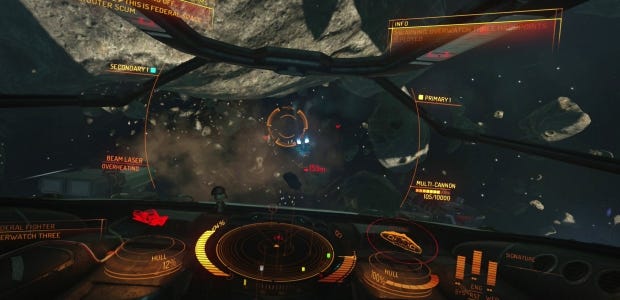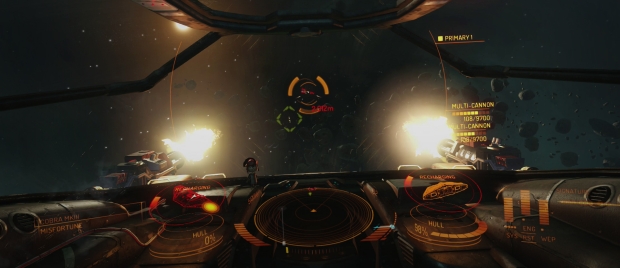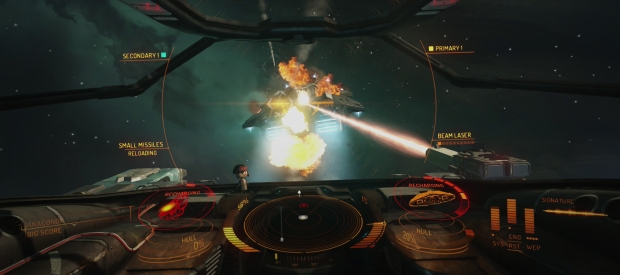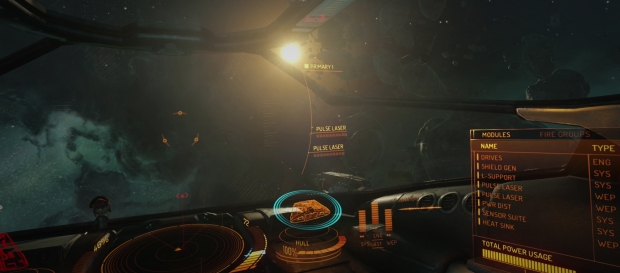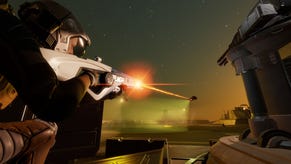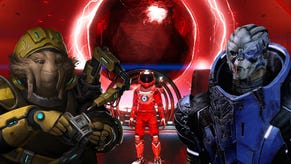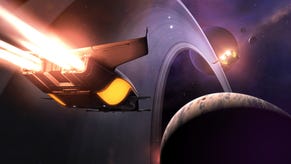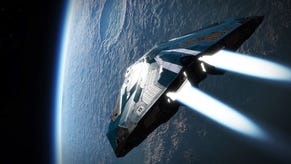Hands-On With Elite: Dangerous
From Lave With Love
In an I-don't-recognise-my-life-anymore moment, Frontier invited me to their offices to be the first person to play Elite: Dangerous. David Braben and his team put me in a room with a joystick that was connected to a PC that was running the first public demonstration of the game. I've no idea how something like that happened to me, but I think I got through it without embarrassing myself, even if I did phone my mum to tell her.
What I was invited to play is the first closed alpha of the game, the one that's just gone live to mega-backers from Kickstarter and the pre-order campaign. This is what it looks like.
It really does look like that. It puts the player a Sidewinder, laden with different configurations in a number of combat scenarios. It could be fire-and hope missiles and gimballed lasers, or a powerful beam laser and guided rockets. The scenarios range from a simple dogfight against an easy opponent, all the way up to a giant battle. I've been asked to not spoil some content, so I'll only talk directly about a few. After watching a few dogfights, I'm asked if I want to play.
HMM? DO I WANT TO PLAY THE NEW ELITE?
I sit down and grab the joystick and throttle: I'm acutely aware that a) I am terrible at using joysticks, and b) I am being watched by David Braben. I'm the first person outside of Frontier to be in this position. I am nervous. I guess he must but nervous. But we're both British, and can put up a cold front that would make an asteroid appear ebullient.
The cockpit view of the Sidewinder has a classic Elite radar at the bottom, some weapons readouts, but little else that's immediately recognisable. There's a holographic read-out that covers your ship and the target, showing where the shields are being hit (important because your ship has locational damage, and in a later battle I die because my cockpit explosively decompressed). There are two weapons groups, detailing your primary and secondary firing solutions. Most importantly to the feel of the ship, there are a three power distribution bars on the bottom right, showing you where power can be rerouted between shields, engines, and weapons. The "feel" of it is what Frontier are most conscious of, and as Braben points out: "It's one of those horribly touchy-feely things. You intuitively know when something's right."
Their intuition feels bang-on so far. I'll get to those bars in a bit, but even without acknowledging them the flight model is superbly balanced. The first enemy I fight is a bit dumb, but as I'm getting used to the controls and the fact that I have three members of the Elite development team watching me (Narrative Designer Michael Brooke and Chief Creative Officer Jonny Watts are also in the room. Watching.), it still takes a short while to grasp, and when I do it's because the systems that they've put in place gives me a good footing.
The little ship is on the radar ahead of me, aloof and uninterested until I start harassing it. I swoop around a little, feeling the UI shake as my (in-game) head reacts to the movement. It feels good: not so speedy that I continually have to adjust for oversteering, but not sluggish. The cockpit's FOV is pretty wide (and can get wider in the options), and the UI is faintly translucent, so it's possible to follow ships that swim to the edge of your vision. For what it's worth, it already "feels" good.
I click the weapons and the two hard-points on either side of the screen pop-out: one is a standard locked position pulse cannon, and the other is a missile launcher. With the enemy targeted, he's surrounded on the HUD by a group of triangles. The one at the front is solid, and the two at the back wireframe, so I can immediately and easily tell his direction and his orientation, and because it's bound to the ship's shape and size, it doesn't overwhelm the UI with information. Allied with the gently fading contrails he leaves behind, it's a really elegant way of following and anticipating the target.
I start firing and he peels off, curling away in an attempt to get behind me. I start to worry a little that we'll be locked together in a chasing-me-chasing-you loop, when I'm told I can game it a little: the throttle is on the right of the radar, and about midway up is a small whited out segment. That little tag tells you the ideal turning velocity to get the best of the other ship, though it changes with relative speeds, so it's not a win button. For deathloops like this, it's a good solution to break the deadlock. And while this one is tough to break out of, it's because in this situation the ships are very similar and I am new to all this: in the final game you can expect a wide-range of differently specced ships.
Braben says: "Even within one ship type there will be quite a range of different ships. It sounds like a contradiction, but you could have a bigger engine, and that sacrifices cargo and/or weapons space, because it's only got certain capacity. You can go for a more expensive engine that might be the same size but higher performance. The whole game is about trade-offs that you can make."
I finally fall in behind the enemy ship and start pulsing away with my main gun. The shields go gradually from blue to orange and then poof. It was easy, but then it's a set-up. It will get a lot more complicated and require a lot more skill in later combat missions.
I hop into a mission where I'll be fighting multiple targets, including an Anaconda (biiiig gunship in this set-up) and its attendant wingment. I arrive and two wingmen of my own draw up beside me. I am again the aggressor, so I need to approach the larger ship and begin the assault before my wingmen will take notice. Here's where those bars on the bottom right come into play. They represent the energy going into your shields, engines, and weapons. Depending on how it's going, you can shunt extra power into one system at the expense of the other two. There are four pips along the bottom of each bar, allowing for expansion and contraction of each system. So, if like me you're on the run from the Anaconda's turrets, it's a good idea to buff the engines or shields at the expense of weapons, because if you're facing away and fleeing, you've nothing to fire on.
All these systems click together to create a pleasingly dynamic dog fighting model. I still died many, many times, against both the Anaconda and the security ships, but I had a moment when I was in a loop with another fighter and I shunted power to the engines, followed his contrails, adjusted my speed to touch the white line, and swooped around to grab him in my sights. This ship had a gimballed laser cannon, which means it was less powerful than the first one, but I could aim it a lot more subtly. It was glorious, and so different from the space-jousting that I became I used to in Frontier when I didn't know any better. Now I do know better, and this is really smart, and rewards piloting skills with a nice, fat explosion.
And that's not even the final set-up. There's one other system that Dangerous introduces to the Elite flight modelling--to do with the ship's heat--that I'll let David Braben explain: "Heat mechanic is wonderful part of the combat to make the battle readable without relying on the dashboard. Seeing almost before it happens or as it happens the response of the other guy, so one of the reasons to see all the retros really big, the rockets, you can see he's turning right immediately. you can see the flare before he starts pulling off. you just get it a few frames earlier. It's that readability. So you can see if they're doing something dramatic it'll suddenly flare with heat. He's either charging his hyper-drive or his weapons are over-heating.
"It all feeds into the stealth mechanic. So the premise is the scanner is relying on electromagnetic and heat that's given out. There's no sound in space. If you suddenly go very quiet and very dark, they can't see you. Especially if you're in amongst other objects, like an asteroid field. In space there will be lots of things like that, lots of environments like a space station and if you just hide in a space station you're just not noticeable. So the ship literally goes dark, and there's this concept of 'buttoning up'. You press a button to do it, and all of your heat vents close. You stop venting heat, and so the heat starts building up quite rapidly. Your engines are continually building up heat. It's very hard to stop. You can shut things down, which reduces the rate it builds up. That's a skill-based mechanic. So you can decide to shut down your shields and shut down your engines and hide. It's a bit like holding your breath - you can only do it for a while, your ship will begin to overheat, and you can choose to either open up, or you can choose to take the damage. "
I was supposed to check this out during a stealth mission. Remember Scavenger Hunt? It was a video that Frontier released last year during the Kickstarter.
One of the missions I played was something simiar: a hunt through an asteroid field, where I was to find and destroy several ships. I was supposed to keep my heat signature low, just nudging along to keep out of their radars, but I'll admit I got a little but gun-happy. Though I was comfortable in the cockpit, I sort of ignored the stealthy part. In my experience, you need to be super good at a game to master its stealth elements, and I'd just gotten used to how messy it was. I tried, but as it happens I was playing the game that everyone who grabs the joystick for the first time does: I was pushing it as far as I could, rather than using gentle, practiced strokes and not burning my engines.
Jonny Watts interjects and explains how the stealth works if it's not being played by an idiot trying too hard to not mess up: "If you've got a really powerful ship hunting you, and he knows you're roughly here and can't see you on his radar. And you know that you're doomed as soon as you appear on his radar, you might choose to take as much damage as you possibly could. You're doomed, anyway. "
I was doomed over and over, but flying through the asteroid fields, accidentally becoming the hunted, did show me just how enjoyable that can be. The environment in space is as important as the ship when it comes to manoeuvring. A guided missile was launched at me, and I reacted by myself, shifting power systems around to boost my speed and then hitting a secondary, temporary speed boost to push away, before cutting the secondary boost and peeling around behind an asteroid to let the missile strike it. Awesome. Though I cut a bit too far and scraped my ship along the asteroid to the combined screams of the Frontier team.
Away from the cockpit--and it was really tough to pull myself away--we talk about the systems that are in place, and why Frontier is putting so much detail into the handling. According to Braben, it's not just about getting the handling correct, though that's a huge part of it, but it's a symptom of the obsessive approach he has to take with this sort of game: "Detail matters to me. All of the control, like being able to direct power to different systems is a really nice mechanic. Down the line you'll be able to wander round the ship, board other ships. We've got that planned. But we need the ships to work. One of the things that's important to me is to be able to judge scale. So you look at something and you can see where you get in and out of it, where does the under carriage come from? They're not great big lumps of cheese: thought's been put into how the cargo is loaded and where it's stored."
Because if they didn't care on that level, if they weren't forcing designers to make sure each ship has the same size player hatch so they can keep a sense of scale in every design, then the rest of the game would suffer.
Braben explains how far they're going with it: "The nearest 150,000 star systems to the Earth, real-life ones, are in the game. As accurately as we can. They still match the night sky. One of the great things, even with Frontier, all of those systems that are in there, all of these things have been discovered by Hubble, by occlusion, by gravitational methods, aren't different to what's there. It's actually very, very close to what's been discovered. I think because I put a lot of effort into the science in the first place it still matches. We don't have to be revisionist at all. The only thing we've been slightly revisionist with, with the embarrassing thing I did with Frontier where I flattened the galaxy to make it easier to navigate, and that's a shame because it changed the distances between the stars.
"But there are really, really wonderful things coming from doing it as accurately as we can. Our night sky is quite dark, because we're very close to the galactic plane, and so the galactic centre is obscured by dust. But you go to somewhere like Achenar, and that's quite a long way out of the galactic plane, so you'd be able to see an amazing vista of a night sky of the Galaxy. And as you move between system and system the night sky will change. It will be the correct night sky for that system, or as close as we can make it. "
And why that's important is because they're in it for the long haul. Frontier believes Dangerous might be the final chapter of Elite, but also the beginning of something immense and far-reaching. According to Braben: "What we're doing with Elite: Dangerous is building a consistent world that we will never need to change again. We'll be able to add to it. I don't think there will be a sequel to this game, ever. It will carry on. The game in ten years' time will look completely different from the game now."
And it's already looking great.
